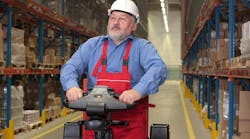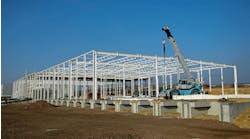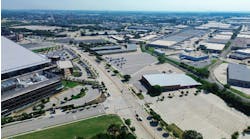According to NIH, the share of workers over age 60 has doubled in the past two decades. This “grey growth” trend includes the transportation and material moving segment, where percentages of seniors have grown as much as 25%. What’s more, many of these older workers are relatively inexperienced, forced by financial pressures into fulfillment operations as a second career. In fact, less-tenured workers are a trend across the workforce. It is estimated that 80% of current loading dock workers have been at their current jobs for two years or less, and 40% less than one year.
Unfortunately, these changes in the makeup of America’s workforce have taken place during a time in which fulfillment operations are getting busier and more chaotic. Often called “The Amazon Effect,” this increased pace of operations is driven by the growth of e-commerce and corresponding consumer expectations of ever-shorter delivery times.
Considering that today’s warehouse employees are either older and/or shorter-tenured than in years past, it isn’t surprising that the transportation and warehousing sector has seen a significant jump in the number of workplace injuries recently (a nearly 20% increase in 2021, per the Bureau of Labor Statistics).
Fortunately, there are several steps that facilities can take to address this problem. From automated dock equipment to programmable, interlocked controls, these upgrades can help companies not only embrace their aging and “new” workforce, but position it for success.
Avoid Overexertion Injuries
One of the first things a facility can do to help its older workers is to phase out manually operated dock equipment. Injuries caused by overexertion represented the largest share of workers compensation claims filed from 2016 to 2020, according to The Travelers Injury Impact Report. Given the aging of America’s workforce, this isn’t surprising, as older workers are more prone to exertion injuries and tend to miss more time when injured. On average, employees miss 71 workdays when filing a claim—the equivalent of 14 work weeks.
Unfortunately, operating outdated, manual loading dock equipment can easily lead to overexertion. It is estimated that 80% of material handling employee back injuries are caused by manual work, such as lifting doors, pulling chains, “walking out” levelers, and other types of manual equipment operation.
Mechanical levelers are a prime example. Activating a traditional mechanical leveler is physically demanding for even the youngest and most fit employee. It involves pulling a chain with up to 70 pounds of force, then walking out the leveler into place to bridge the gap between the loading dock floor and the trailer bed. These antiquated pieces of machinery shouldn’t be kept unless a facility receives minimal dock traffic and/or has a relatively youthful workforce.
Hydraulic levelers, on the other hand, provide workers the convenience of being able to raise and lower this heavy piece of equipment with the simple push of a button. Considering the average loading dock leveler services eight trucks per day, that’s a lot of bending over, lifting and pulling being eliminated.
And it’s not just the leveler that can be operated automatically with a push-button. Loading dock controls can incorporate other heavy pieces of equipment, like dock doors, dock safety barriers and vehicle restraints.
Vehicle restraints are perhaps the most important of these. Modern vehicle restraints connected to a control system will automatically secure a fully backed-in trailer with the push of a button on the control box inside. This not only saves workers from having to bend over and manually lock the trailer into place or chock the tires, it also keeps them off of the dangerous drive approach. Since OSHA has reported that tractor-trailers are the second leading cause of back-over deaths in the country, this is a huge safety benefit for workers of all ages.
Additionally, modern control systems can be interlocked and programmed to function only in a safe sequence of operations, which is especially important for facilities with a preponderance of inexperienced workers. With this programming, the hydraulic leveler and/or overhead door is disabled until the vehicle restraint is safely engaged. Once the vehicle is secured, the overhead door can be opened, the dock barrier released, and the leveler extended into the trailer bed. After loading/unloading, the restraint is not allowed to disengage the trailer until the leveler is taken out of the trailer and stored safely.
By helping eliminate the potential for human error in operating dock equipment, the “safe sequence” programming enhances worker safety and protects the facility from worker’s compensation claims, damaged product and equipment, and costly downtime.
Minimizing Whole Body Vibration
Forklift operation presents another challenge for older employees. With tires that are often made from solid rubber and no suspension system, some older forklifts deliver an extremely stiff, uncomfortable ride. Any bump or hump intensifies this, exerting pressure up through the bottom of the forklift and into a driver’s spine, shoulders and neck. Not surprisingly, more than one-in-five forklift drivers suffer from back and/or neck injuries.
In the short-term, forklift operators can experience various musculoskeletal (MSD) disorders, including pain in their legs, back, and neck. A first-time back injury to a worker can cost a company anywhere from $30,000 to $100,000 in indirect costs, such as missed work time. Long-term, forklift operators can be left with chronic pain that lasts beyond their working years. Older employees are more prone to all these issues.
Outdated dock levelers are one of the most common causes for this problem. Because of their bumps and gaps, a forklift driver crossing over a leveler between warehouse and trailer may experience a jarring, whole body vibration known as “dock shock.” The first vibration point is typically located where the leveler deck meets the warehouse floor (rear hinge), while the second occurs when the lift truck passes from deck to lip (front hinge). The third vibration point is generally at the front lip edge as the forklift goes into (and especially out of) the trailer.
Today’s levelers can help create a smoother transition as forklifts cross into and out of trailers. These ergonomically designed levelers help alleviate whole body vibration, reducing dock shock by up to 50% when paired with modern forklifts. They can cut it up to 120% when combined with a stabilizing trailer restraint (which minimizes horizontal sway and vertical movement that can occur during loading and unloading).
Minimizing dock shock and trailer sway not only enhances employee comfort, but it also reduces damage to forklifts and the products they carry. Additionally, enhancing the smoothness of the ride during loading and unloading can help protect the expensive computer componentry of AGVs. This all translates into lower maintenance costs, less time spent on maintenance or costly loading dock downtime, and increased worker productivity.
Another product that can be used to keep the trailer steady and keep the bed ergonomically level during loading and unloading is a trailer lift. Trailer lifts help facilities that receive trucks with a wide variety of trailer bed heights to lift and match the trailer bed floor with the dock height. Due to the platform shape, the trailer lift maintains a flat surface, which in turn helps remove the decline into—and incline out of—the trailer to help prevent forklift operators from having to excessively twist and turn their necks and backs.
Help Reduce Injury Risks for Aging and Less-Tenured Workers
Warehouse and distribution centers can be dangerous and physically demanding workplaces. Workers not only face threats as they constantly interact with trucks, forklifts and other machinery, they also encounter injury risks from equipment they operate, including MSD issues and other injuries due to overexertion, bending and lifting.
Fortunately, more and more organizations are recognizing these risks and working to limit employee exposure to musculoskeletal disorders and related injuries. In fact, more than 100 have signed the Musculoskeletal Disorder Pledge. Coordinated by the National Safety Council and Amazon, the MSD Pledge provides access to shared expertise from like-minded companies, as well as the latest research-based insights.
Adherence to industry best practices such as those outlined in the MSD pledge can greatly help companies achieve their safety and employee goals. One of the first steps organizations can take is to upgrade their facilities away from outdated, manual dock equipment and implement a systematic approach that incorporates automatic vehicle restraints, hydraulic, ergonomically designed dock levelers, and integrated control allowing for safe sequence of operation programming.
By investing in modern logistics equipment for their facilities, organizations can protect their aging and/or inexperienced workforce, enhance its efficiency and grow their bottom line.
Joe Ellestad is a director with Rite-Hite, a provider of loading dock safety systems, industrial door solutions and in-plant products.



